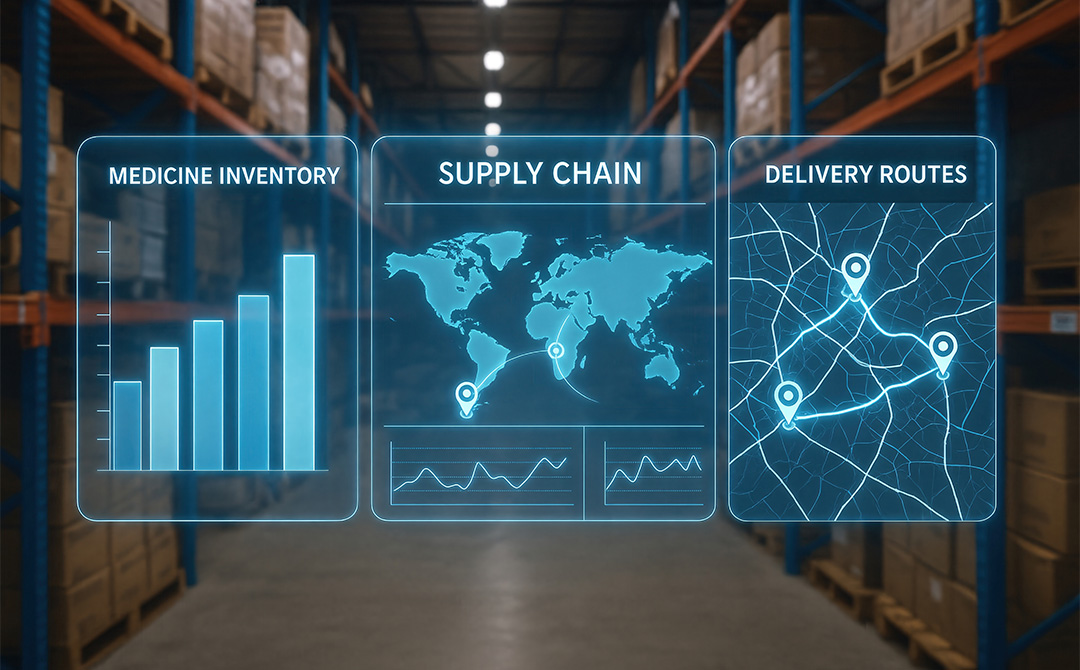
Healthcare, in recent years, has reached a tipping point in technological advancement, where everyone associated with the system is benefiting from it significantly. Starting from clinicians to patients, and other stakeholders, AI has created an intersection that has welcomed new possibilities and has opened new doors to stay connected with the patient while providing compassionate care.
Thanks to advanced tools and platforms, manual documentation has reduced significantly, diagnostic accuracy is up by multiple notches, and patient engagement has risen overall. This concept and the gradual shift towards a more inclusive but productive output in healthcare is known as ambient clinical intelligence.
This emerging field in healthcare makes use of natural language processing, voice recognition, and contextual learning to let clinical data be collected passively while physicians and patients discuss their cases and treatment.
For healthcare leaders, this shift marks not only an evolution in how care is recorded but also a revolution in how it is delivered.
What Is Ambient Intelligence
Ambient intelligence collectively refers to an environment where different types of devices and AI systems work together to respond to real humans with the highest accuracy, in the most natural way possible, understand their typical behavior, and even predict their intent. Interestingly enough, this idea of interconnected systems was originally conceived for smart homes and connected cities, but later on, ambient intelligence found a profound and more impactful home in the healthcare sector. In this sector, the chances of its success seemed higher with a better chance at making real change for real people.
In clinical environments, ambient intelligence functions within the healthcare context by listening to, learning, and understanding the unique dynamics of how a doctor interacts with their patient. Rather than depending on manual data entry, these systems observe and process information in real time to produce contextually relevant summaries and insights. This smooth integration of human understanding with automation is helping create a more natural and unobtrusive healthcare experience.
What Is Ambient Clinical Intelligence
Ambient intelligence has been one of the top AI trends of 2025 wherein clinics are making use of more than just simple AI models known for having only structured data inputs and predefined algorithms. Instead of simply processing information that has already been recorded, it works in real time, interpreting words that are being spoken, the type of tone that’s accompanying the words, and contextual cues that are being set up before the conversation happens.
Thus proving that none of these systems work in isolation, they work together to set up a cohesive intelligence that is aware of everything that happens within a conversation and is limited to pre-defined scripts and training that stagnates after a while. This approach is not a replacement for clinicians but a way to empower them with tools that relieve administrative strain while strengthening their ability to focus entirely on patient care.
Unlike legacy AI clinical documentation tools that are bound by rigid templates and at most, can produce post-visit transcriptions, ambient clinical intelligence integrates naturally into every aspect of how a clinical works.
Feature-wise, it is smart enough to recognize the voices of multiple speakers, discern one medical context from another, and automatically create electronic health records with structured and unstructured information without disrupting the flow of conversation.
Core Technologies Behind Ambient Clinical Intelligence
Like every successful new tech and its deployment, this advanced intelligence is supported by an intricate combination of technologies that is capable of understanding the nuanced and sometimes complicated nature of human communication.
- Natural language processing forms the foundation of ambient clinical intelligence by letting machines learn and deeply understand medical language.
- It can interpret acronyms, which is very important in clinics, as most tests and diagnostic processes are referred to using acronyms.
- Speaker diarization is another core element that helps these AI systems differentiate between the voices of doctors, nurses, and patients.
The goal here is to make sure that the recorded data accurately reflects who said what during an interaction. This technology, combined with contextual understanding, empowers the system to capture the emotional tone and medical intent behind each statement rather than just transcribing spoken words and making literal translations out of it.
-
Real-time analytics is another technology that benefits these platforms as they continuously process information to generate data that can improve healthcare services and the overall productivity of the staff.
When integrated with clinical intelligence tools and platforms, they give direct access to past data and other relevant information, directly to the clinician or whoever else is in charge of care delivery at that moment.
Burnout is increasing in frequency and severity. A recent survey of > 2,400 physicians noted a dramatic increase in burnout, with 62.8% of respondents manifesting at least one symptom (Source). Here are the main benefits of incorporating ambient intelligence in healthcare settings that can help tackle this fatigue:
- Lesser Documentation Overload: The actual, real-life, and possibly the best benefit of ambient clinical intelligence is its ability to simplify the most time-consuming aspect of healthcare - documentation.
Clinicians often spend nearly half their working hours entering notes into EHR systems for every case diagnosed and treated. This is nothing but administrative overload that not only leads to burnout but also reduces the time available for meaningful patient interaction.
One of clinical intelligence's core agendas is to sort this issue through ambient clinical documentation, where data is automatically recorded and categorized as clinicians speak naturally with patients. This unobtrusive data capture makes sure that no critical information is missed while removing the need for repetitive manual entry or verbal repetition by the patient.
- Better Documentation Accuracy: Another important benefit is the improvement in documentation accuracy. Since the technology analyzes the entire context of a conversation rather than just picking up on isolated phrases, ambient clinical intelligence decreases the risk of misinterpretation by a noticeable margin and makes sure that the clinical record accurately represents the patient’s condition and treatment plan.
- Improved Care: From the patient’s perspective, this means that the technology is improving the quality of engagement they are receiving from the healthcare worker, the latter of whom is no longer having to divide their attention between manual work and treatment-related conversations.
Clinicians can maintain eye contact, listen actively, and work on building a deeper trust. This improved experience ultimately will contribute to better outcomes for ambient clinical intelligence.
|
Case Study: The U.S. healthcare system generates massive volumes of patient–provider conversations daily, but documenting them manually often leads to errors, inefficiencies, and miscommunication between different teams responsible for the care. To solve this, an AI-based summarization system was set up with the help of an AI consultation guide that would automatically convert unstructured clinical conversations into structured, HIPAA-compliant summaries. Built within just a month, first as an MVP and then as a fully viable solution, it was used for contextual understanding and integration with existing healthcare systems. After each consultation, the model processed provider notes and generated concise, standardized summaries that could be shared with multiple members involved in the process. This automation saved clinicians roughly ten minutes per patient visit, letting them focus more on the interactions they were having with the patients and reducing burnout. This system maintained better care while strengthening the collection and utilization of data for proper reasons, creating a more efficient and collaborative healthcare environment. |
Ambient Clinical Analytics Pipeline
For healthcare organizations looking forward to adopting ambient clinical intelligence, they need to first understand how the underlying analytics pipeline works to make this entire system a success.
- Data captured from clinical interactions is first processed at the machines and devices where ambient devices, such as microphones or sensors where conversations are used to record conversations. This initial stage involves noise filtering and real-time transcription that ensures only relevant speech data moves forward for deeper processing.
- Once they are transferred securely to the cloud, data undergoes ambient clinical analytics, where AI models extract major concepts such as symptoms, diagnoses, medications, and follow-up actions.
- The integration of machine learning algorithms then allows for continuous learning from every recorded interaction, helping the system learn new clinical terminologies or evolving conversational styles.
A privacy-first architecture is very important when it comes to protecting sensitive patient data, and it is mostly done through encryption and anonymization protocols. The use of federated learning is solely set up to make sure that model improvements can occur without exposing private medical information.
Strict security and governance standards are thus helping healthcare institutions to adopt alongside ambient intelligence in healthcare.
Challenges in Ambient Clinical Intelligence
Implementing clinical intelligence comes with some practical challenges that healthcare organizations must address to make sure that its adoption is ultimately successful. Understanding these obstacles in a structured way can help leaders plan mitigation strategies as soon as they start planning..
|
Challenge |
What is it About |
Impact / Consideration |
|
Ambient Noise |
Hospitals are dynamic spaces filled with overlapping voices, alarms, and environmental sounds, making it difficult for systems to accurately understand the fine line between relevant and irrelevant input. |
This can reduce transcription accuracy and require advanced noise-filtering algorithms. |
|
Data Quality |
Real-time data streams may be affected by inconsistencies in microphone placement, speech clarity, or contextual labeling. |
Poor data quality can lead to inaccurate clinical records and misinterpretation of patient information while implementing ambient clinical intelligence. |
|
EHR Integration |
Existing electronic health records often follow rigid data structures that may not be fully compatible with AI-generated documentation. |
Integration complexity can delay implementation and reduce workflow efficiency. |
|
Privacy Compliance |
Organizations must adhere to regulations such as HIPAA and GDPR, ensuring patient consent and data minimization in every data capture and processing step. |
Integration complexity can delay implementation and reduce workflow efficiency. |
|
Change Management |
Clinicians must trust that ambient clinical intelligence complements their expertise rather than replaces it. |
Lack of clinician buy-in can hinder adoption; collaborative implementation and early involvement improve acceptance. |
Best Practices for Implementation
For any healthcare setup to successfully integrate ambient clinical intelligence into its systems, certain best practices need to be adopted no matter what. For most workflows, organizations must look into best practices that will make this a success..
- The first step is maintaining a human-in-the-loop validation process where clinicians can review and correct system-generated documentation before it becomes part of the official record. This not only makes sure that the ultimate output is accurate but also allows the models to learn continuously from expert feedback.
- Continuous model retraining is another vital practice that clinicis have to ready for, in the initial few day. Medical language is evolving constantly, and new diseases, treatments, and diagnostic patterns are emerging almost every year.
- When models are retrained using recent data, healthcare providers will make sure that their ambient clinical intelligence systems are up to date and contextually aware of what’s changing around them. This also will reflect in the form of better and more accurate AI personalization for each and every patient that walks through the doors.
- A strict governance framework is also important for keeping accountability intact and compliance on track. This can be achieved by outlining where the clear ownership of data will be, the decision-making protocols that will be followed and how transparent and understandable its processes are for all..
Strong management of the AI's entire lifecycle and monitoring of compliance solutions will create ecosystems that will make every use of ambient clinical technology stay in line with the ethical considerations and operational best practices.
Here’s a representation of the facts in a tabular manner.
|
Aspect |
Best Practice |
Purpose / Benefit |
|
Human validation |
Clinicians review and correct system-generated documentation before it’s finalized. |
Ensures accuracy, maintains clinical trust, and helps models learn from expert feedback. |
|
Continuous model retraining |
Regularly update models with recent medical data, terminology, and trends. |
Keeps systems contextually aware, relevant, and aligned with evolving medical practices. |
|
Governance framework |
Establish clear data ownership, transparent decision-making protocols, and audit trails. |
Maintains accountability, compliance, and ethical oversight. |
|
AI lifecycle management |
Monitor and manage AI systems from deployment to maintenance, ensuring compliance tracking. |
Promotes ethical use, operational consistency, and adherence to regulatory standards. |
Importance of Integrating it with Enterprise Ecosystems
The success of ambient clinical intelligence depends largely on how easily it can be integrated into other important enterprise systems used by the healthcare clinic. Modern healthcare environments are heavily reliant on interconnected technologies that manage everything from the moment a patient registers themselves to the final billing, the diagnostic data and inferences, and the type of care that has been planned and executed for the patient.
To deliver its full potential, it must effectively work with these platforms.
- Integration with EHR and electronic data capture systems ensures that automatically generated documentation is inserted directly into existing digital records without needing any manual work from the administrative staff.
- When linked with clinical decision support systems, it provides users with live insights that can help make care choices better during the consultation itself.
Analytics dashboards further extend the impact of ambient clinical intelligence by turning recorded interactions into actionable intelligence for healthcare administrators. When connected with process automation workflows, organizations can make repetitive administrative tasks such as appointment scheduling, claims processing, or follow-up reminders very easy to follow through.
What to Look Out for in the Future
The future of ambient clinical intelligence promises even more sophisticated capabilities that will further bridge the gap between human empathy and technological efficiency.
- One emerging trend is emotion recognition, where AI can identify and make a correct note of stress, pain, or anxiety in a patient’s voice.
- This feature will let clinicians customize their style of communication and treatment approach more sensitively.
- Voice biometrics will play an important role in patient identification and authentication, reducing the need for manual verification processes while offering some of the best possible security.
- Predictive ambient insights will enable healthcare providers to anticipate patient needs and clinical risks through analysis of subtle speech or behavioral patterns captured during interactions.
In the long term, it will ultimately boil down to care assistants powered by ambient intelligence vs artificial intelligence frameworks that will go on to support clinicians in both administrative and monitoring tasks.
The Importance of Having the Right Partner in Healthcare
Healthcare leaders ready to embrace this next phase of innovation can gain a powerful AI consulting ally in Tredence, a trusted partner empowering global organizations to implement ambient clinical intelligence platforms that unite contextual awareness with AI-driven precision.
With high-end patient-centric data and AI integration, data privacy assurance, and a platform design that can scale alongside the facility, we help clinics transform their vision into reality.
Now is the time to partner with Tredence and lead the shift toward a future where ambient systems operate silently but intelligently, making sure that care becomes more personal and profoundly impactful.
Contact us today and let’s get started.
FAQs
1. What data sources are required for ambient clinical intelligence?
It depends on a variety of data sources, including patient-clinician conversations, electronic health records, sensor inputs, and contextual information gathered during clinical interactions, which together developthe system that understands intent, extract meaning, and generate accurate documentation.
2. How is patient privacy maintained with ambient data capture?
Patient privacy is maintained through secure data handling practices where information is encrypted, anonymized, and stored within protected healthcare systems, making sure that only authorized personnel can access it while all captured audio and contextual data are processed responsibly in compliance with established healthcare privacy regulations and ethical standards.
3. What are the common challenges when deploying ambient clinical intelligence?
Organizations often face challenges like managing background noise during data capture, ensuring compatibility with existing healthcare systems, training staff to use new tools effectively, and maintaining accuracy when processing real-world conversations while also ensuring that privacy, compliance, and system reliability are consistently upheld throughout implementation.
4. How long does it typically take to implement an ambient clinical intelligence solution?
The implementation timeline depends on the size of the healthcare organization, existing digital infrastructure, and integration complexity, but typically it can take a few months to design, pilot, and refine the system so it can accurately capture, process, and summarize conversations without interrupting the clinical workflow.
5. How do you measure the ROI of ambient clinical intelligence initiatives?
Return on investment is measured by evaluating improvements in clinician efficiency, reduction in documentation time, better patient satisfaction scores, and overall accuracy of medical records, alongside cost savings from decreased administrative workload and higher-quality data that ultimately contribute to better clinical decisions and patient outcomes.

AUTHOR - FOLLOW
Editorial Team
Tredence
Next Topic
AI for Clinical Documentation: A Clinical Documentation Leader’s Blueprint for Efficiency & Compliance
Next Topic




